I’m sure you’ve noticed that home pregnancy tests (HPTs) come in many different styles. Some brands have pink dye, while others have blue dye.
Some have a control line with a second line to indicate you’re pregnant. The second line may be parallel to the first one or in a plus sign. You can even buy digital versions that spell out the words “pregnant” or “not pregnant.”
If you’re using one of the home pregnancy tests that display lines, you will no doubt find yourself wondering how much the darkness of the second line matters.
Generally speaking, if you see a second line at all, that is considered a positive result. Our bodies only produce hCG (the hormone that pregnancy tests are looking for) when we’re pregnant.
So don’t discount that second line just because it’s faint. But definitely do show the test to at least one other person, in case your eyes are playing tricks on you.
I have seen MANY women post pictures online of an absolutely clear negative result, convinced they can see a second line where none exists.
I’ve also seen women post pictures of a clear positive, because they were too nervous to believe the second line is really there! Anxiety and wishful thinking can work both ways. A second opinion is a good idea.
The Importance of Following the Directions Correctly on a Home Pregnancy Test
This sounds obvious, but to get an accurate result on a pregnancy test, you have to follow the directions properly.
You might wonder how it’s possible to pee on something incorrectly, but it is easier than you think. Here are some common ways that people take a home pregnancy test wrong:
- If you drink a ridiculous amount of water before you take the test, your pee might be too diluted to give an accurate result. You could end up with a false negative.That’s one reason people recommend taking home pregnancy tests first thing in the morning, with First Morning Urine (FMU).
- If you don’t read the results within the time window the manufacturer indicates, you could end up with a false result. In other words, if the box says to wait for three minutes, wait for three minutes. Don’t panic if the second line doesn’t immediately appear.But you also shouldn’t fish your test out of the trash the next day, hoping to “discover” that it’s suddenly positive. Accept whatever answer you get at the end of the three minutes.
- If you take the test way too early in your cycle, you could end up with a false negative. I know it’s tempting to jump the gun and test at 9 dpo, but you have to give that potential embryo time to build up enough hCG levels to register on a test.Taking a test too early and then wondering if you should have waited is a mind game. Maybe you’re into that, but I wasn’t!
In addition, some test manufacturers want you to hold the dipstick — yeah, that’s what it’s officially called, just like when you’re checking your car’s oil! — under you while you pee on it, and others want you to dip it in a cup.
By the way, you should get used to that — if you’re pregnant, you’ll have to pee in a cup at your prenatal appointments to check for preeclampsia. I never said this process was glamorous!
I doubt using the other method would change the results much, but it’s never a bad idea to follow the directions as closely as you can.
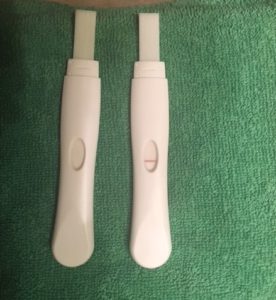
These tests were taken by the same person (me!) on the same day. The one on the left got wet too far up the dipstick, so it does not show any lines at all.
If you think you got a positive result but you’re afraid to get your hopes up, you should definitely consider going to your doctor for a beta test. A beta test will show how much hCG is in your blood, which will confirm if you are really pregnant or not.
Many fertility clinics would prefer if you just went in for your beta to begin with and didn’t bother with the home tests, but it can be really hard to wait!
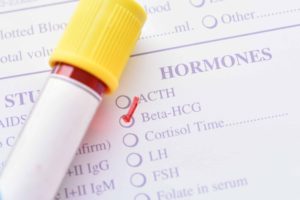 Another option is to take another pregnancy tests in a day or two. Try taking a picture with your phone so you can compare the results.
Another option is to take another pregnancy tests in a day or two. Try taking a picture with your phone so you can compare the results.
If you’re really pregnant and the first test had a faint second line, the line on the next one should be darker. This means that your body is producing greater levels of hCG, which is a promising sign. In a healthy pregnancy, hCG increases very rapidly in the first weeks.
If you took a trigger shot, such as Ovidrel, in the past two weeks, that could lead to an inaccurate result as well. For more information on that scenario, see my post Can Ovidrel Cause a False Positive on a Pregnancy Test?
As I explain in that post, some women like to “test out the trigger” by taking a series of home pregnancy tests in the lead-up to the day their period is due. If they are pregnant, the tests will go from positive to negative (when the trigger shot is out of their system) and back to positive.
I personally thought that was a waste of emotional energy (not to mention money), but everyone handles the Two Week Wait differently.
Speaking of the Two Week Wait, it’s a really good idea to avoid symptom-spotting as much as you can. It’s easier said than done, I know. I was one of those crazy people Googling early pregnancy signs like it was my job.
The problem is that many of the so-called early pregnancy signs, like nausea and moodiness, are also signs of rising progesterone, and progesterone naturally rises in the second half of a healthy cycle before you get your period.
Add some fertility meds to the mix, and your hormones are all over the place. It’s just really hard to tell what’s going on until a little more time has passed. I explain this in further detail in the post Symptom Spotting: How to Tell a BFP from PMS.
Why the TTC Community Prefers Home Pregnancy Tests with Pink Dye
If you frequent online TTC or fertility forums, you’ll notice that most women are on Team Pink Dye. A lot of people find pregnancy tests with pink dye easier to read than tests made with blue dye.
In addition, tests that use blue dye are thought to cause more evaporation lines, which are basically caused by the test getting wet. That might be because evaporation lines are pale gray, and gray is easier to confuse with blue. If you see a line that is actually blue or pink, though, that is not an evaporation line!
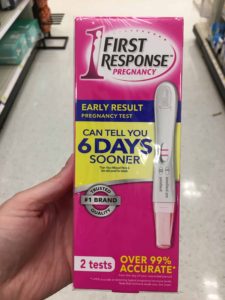 One popular pink-dye pregnancy test is the First Response Early Result (Amazon link), which is often just called “FRER” online. (In fact, I will add that to the Glossary!) The image at the top of this post is my very own FRER, and it was unambiguously positive.
One popular pink-dye pregnancy test is the First Response Early Result (Amazon link), which is often just called “FRER” online. (In fact, I will add that to the Glossary!) The image at the top of this post is my very own FRER, and it was unambiguously positive.
That’s considered a very strong line for 13 dpo.* My hCG levels were high, and I had triggered with three mature follicles. My doctors were not surprised that it was a twin pregnancy.
If you’re curious about your chance of conceiving multiples on fertility medications, check out the post Will Clomid Make You Have Twins?
The FRER can detect hCG levels as low as 6.3miU/ml. The company advertises that their test can detect pregnancy as soon as 6 days before the missed period — with some fine print, of course. Most other tests need at least 20 miU/ml to register as positive.
*Notice that I took this test at 13 dpo, despite saying throughout this post that you should wait until your missed period (generally 14 dpo). I obviously didn’t take my own advice. I had actually planned on waiting one more day, but I got up that morning and just had to do it. I knew it was going to be positive.
Very Early Pregnancy Tests: A Double-Edged Sword
While we can have philosophical debates about “the moment life begins,” it’s hard to consider a fertilized egg a pregnancy. The fertilized egg needs to implant in the uterus to begin producing hCG and developing into a fetus.
That’s one reason the endometrial lining is so important for conception. For more info on that, including ways to improve the thickness of your lining, check out Can You Get Pregnant With a 5 mm Endometrial Lining?
Implantation can happen from 6 to 12 days after ovulation, which is actually a big window when you are an anxious fertility patient in the Two Week Wait! Most of us want to know if we’re pregnant as soon as possible, without any second-guessing.
Technology has made home pregnancy tests more sensitive, but it can’t make implantation happen sooner. Home pregnancy tests will show a positive result sooner when the implantation was relatively soon after ovulation, because the hCG levels have had more time to build.
If your embryo took 10 days to implant and you’re testing on 10 dpo, you’ll probably get a false negative.
In other words, you are still better off waiting until your missed period to take a home pregnancy test, no matter how sensitive the test is.
The results are much more likely to be accurate at that point, whether you had an “early” or “late” implantation.
(In case you are wondering, how long the fertilized egg took to implant doesn’t mean anything in terms of the health of the pregnancy. There’s nothing wrong with a “late” implantation — it’s just one of the natural variations in this whole process.)
Another downside to taking pregnancy tests as soon as it’s technologically possible is that many women end up learning about a pregnancy that is not destined to be successful.
Decades ago, women and their doctors had no way of knowing that these very early miscarriages had even happened. Maybe women noticed that their period was a day or two late, but that’s it.
That still happens today, of course — but not to women doing fertility treatment. We do all the testing as soon as possible, so we may find out about an early loss that another woman might have been blissfully unaware of. Women who did fertility treatment are also likely to get transvaginal ultrasounds at 6 or 7 weeks.
Unfortunately, pregnancy loss in the first few weeks is unbelievably common, due to all kinds of factors outside of anyone’s control. I’m sorry. I wish I could say something to make it easier. When you have worked so hard to get pregnant and stay pregnant, it makes a healthy baby an even bigger miracle.
I cover more miscarriage-related info in my posts TTC a Rainbow Baby: Overcoming Recurrent Pregnancy Loss and TTC After a D&C: How Soon Can You Try Again?
What About Those Women Who NEVER Got a Positive Home Pregnancy Test?
You’ve probably heard about women who never got a BFP on a home pregnancy test despite being several months pregnant. It can happen, although it’s not common. It just means that for whatever reason, the hCG didn’t transfer into the urine.
Also, the amount of hCG that a pregnant woman produces is not standard. There’s more variation than you might expect.
That doesn’t mean you should keep your hopes up forever, though. If you haven’t gotten your period for a while and you keep getting negative results on home pregnancy tests, you are probably not pregnant.
The more likely explanation is that you didn’t ovulate that cycle. Eventually, you may need to take Provera to reset your system and start a fresh cycle. My posts How to Take Provera When TTC and When Do You Ovulate If You Have 45-Day Cycles? may be helpful if you’re in that situation.
Even if you are one of these unicorn women who somehow don’t register as pregnant on a urine test despite being pregnant, it would be pretty bizarre for a blood test to miss the pregnancy. That’s yet another reason to get a beta at your doctor’s office!
Some doctors give patients a hard time for asking for a blood test when their home tests are negative, but a knowledgeable ob/gyn or fertility specialist shouldn’t. As I said, many specialists prefer it. The blood test gives them more information.
Conclusion
No, a faint second line on a home pregnancy test is not a negative result. It probably just means that you tested relatively soon after implantation.
You can either call your doctor for a beta hCG test, or wait a few more days and see if the second line is darker on a new test. As always, I wish you the best of luck! <3
The FRER is one of the essentials included in Infertility Starter Pack. Head over to that page for more recommended products!
This post was last updated in May 2020.

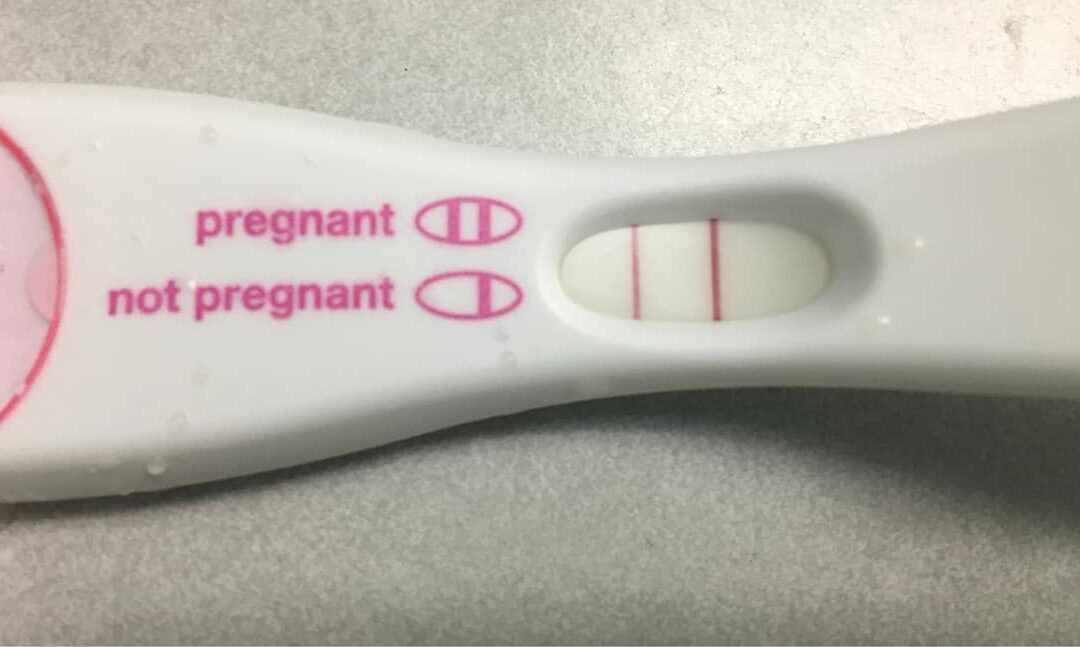
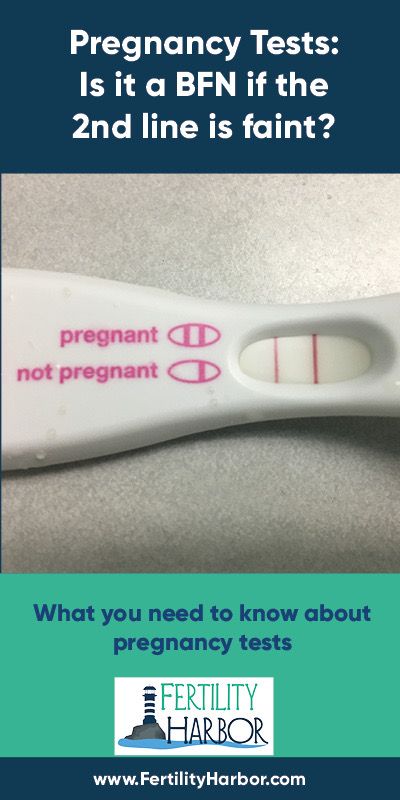
 I’m Jenn! Here I am with my beautiful twin boys. My pregnancy was possible thanks to fertility treatment for PCOS.
I’m Jenn! Here I am with my beautiful twin boys. My pregnancy was possible thanks to fertility treatment for PCOS.


